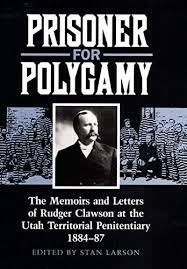Articles/Essays – Volume 27, No. 1
Prisoner of Ideals | Stan Larson, ed., Prisoner for Polygamy: The Memoirs and Letters of Rudger Clawson at the Utah Territorial Penitentiary, 1884–87
Prisoner for Polygamy is not simply another volume in the vast collection of diaries, histories, auto- biographies, and biographies of Mormon polygamists. Rather it is a slice of life, a document describing the immediate consequences of living the principle.
From its inception, members of the Church of Jesus Christ of Latter-day Saints boasted they would give up property, family, and life for the restored gospel, including polygamy. The 935 men incarcerated for living the principle between 1884 and 1895 made good on this claim. Prisoner for Polygamy: The Memoirs and Letters of Rudger Clawson at the Utah Territorial Penitentiary, 1884- 1887, is the story of one of these men, the story of his ideals and integrity. Rudger Clawson’s memoir is based on the journals he kept while an inmate in the Utah penitentiary.
Stan Larson’s volume includes Clawson’s memoir; love letters to his plural wife, Lydia; appendices containing Clawson’s 1884 prison journal; and lists of Mormon polygamists imprisoned in the Utah penitentiary and of Clawson’s family. It also includes a bibliography of various diaries, journals, and autobiographies of Mormon polygamists held in the Utah prison.
Rudger Clawson was the son of polygamist Hiram B. Clawson and his second wife Margaret Jay Judd. He was a prominent member of the LDS church serving as missionary, stake president, mission president, apostle, president of the Quorum of Twelve Apostles, and counselor in the First Presidency. Clawson married Florence Ann Din woody in August 1882. Seven months later, he married Lydia Spencer at the Salt Lake Endowment House. By early 1884 polygamists were being prosecuted under the Edmunds Act.
On 24 April 1884 a grand jury indicted Clawson for polygamy and unlawful cohabitation. When Clawson came to trial in October 1884, the jury could not agree on a verdict and Judge Charles S. Zane declared a mistrial. Later that night federal deputies located Lydia Clawson and served her with a subpoena. Lydia refused to testify at Clawson’s retrial and was put in custody for contempt of court. Clawson begged Lydia to testify so she would not have to remain in prison.
After Lydia’s testimony the jury found Clawson guilty. Clawson was sentenced to three and one-half years and a fine of $500 for polygamy and six months and $300 for unlawful cohabitation to be served consecutively. Clawson was the first Mormon convicted and imprisoned for violation of the Edmunds Act.
Clawson’s memoir describes the details of prison life including an initiation ceremony, food, inadequate hygiene facilities, and the nuisance of bedbugs. Prison life was routine and monotonous. Inmates had plenty of spare time. Some read books, some tried their hand at writing and publishing poetry, played baseball, football, boxing, quoits, lacrosse, croquet, marbles, chess, checkers, dominoes, and cards. Others tried their hand at various crafts, including: making hair bridles, riding whips, gilded picture frames, ornamental wood boxes, flower carvings, ship models, canes, mats, fans, women’s chains, and pincushions. Clawson who at tended school at the University of Deseret worked for several months outside the prison wall tutoring the warden’s two children.
After serving three years, one month, and ten days of his sentence, Clawson was pardoned by U.S. president Grover Cleveland. As a reward for defending the principle, Clawson received his second anointing and was appointed president of the Box Elder Stake. Clawson entered into a post Manifesto union with Pearl Udall in 1904.
The Clawson memoir lacks the literary merit of Annie Clark Tanner’s autobiography, A Mormon Mother. The memoir never achieves the quality of compelling storytelling found in Tanner’s book. Characters in Clawson’s memoir are not fully developed. We do not see Clawson, the hero of the story, grow as the years pass. We are not shown what Clawson learned about his fellowman while in prison or how he changed as a result of his prison experience.
The memoir was written during an era of religious zealotry. The tone of this document, like the journals on which it was based, is formal and full of religious posturing. Clawson’s rhetoric is stuffy and humorless. While the memoir is a testimony to Clawson’s integrity, it also confirms his racist attitudes and class consciousness. Clawson’s letters to his plural wife, Lydia, on the other hand, are intimate, playful, sensual, and endearing. They are compelling because Clawson writes for an audience he knows—Lydia.
Clawson’s memoir and letters pro vide valuable insights into prison life. The book is an important volume in the history of Mormon polygamy. This is the story of a man committed to the principle of plural marriage: a man who lived it, suffered for it, and continued to live it. The book reminds the reader that the time “cohabs” spent in prison was more than a curious footnote in the history of Mormon polygamy. The memoir brings to life the prisoner’s daily rou tine, it dramatizes his contentions, hu miliation, and suffering at the Utah penitentiary.
Prisoner for Polygamy: The Memoirs and Letters of Rudger Clawson at the Utah Territorial Penitentiary, 1884-87. Edited by Stan Larson (Urbana: University of Illinois Press, 1993).


 Back to full Issue
Back to full Issue

